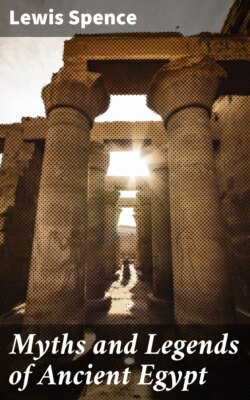Читать книгу Myths and Legends of Ancient Egypt - Lewis Spence - Страница 7
На сайте Литреса книга снята с продажи.
Animism
ОглавлениеIt has been admitted that the ancient Egyptians, like other early races, could not have evolved a religion unless by the usual processes of religious growth. Thus we discover, by means of numerous clues more or less strong, that they passed through the phase known as animism, or animatism.[1] This is the belief that practically every object in the universe surrounding man has a soul and a personality such as he himself possesses. Man at an early date of his consciousness formulated the belief in a soul, that mysterious second self which even the most debased races believe in. The phenomena of sleep, the return of consciousness after slumber, and the strange experiences of life and adventures in dreamland while asleep would force early man to the conclusion that he possessed a double or second self, and it was merely an extension of that idea which made him suppose that this secondary personality would continue to exist after death.
But what proof have we that the early dwellers in Egypt passed through this phase? Besides the belief in a human soul, the animistic condition of mind sees in every natural object a living entity. Thus trees, rivers, winds, and animals all possess the gift of rational thought and speech. How is it possible to prove that the ancient Egyptians believed that such objects possessed conscious souls and individualities of their own?
First as to the early Egyptian belief that man himself possessed a soul. The Egyptian symbol for the soul (the ba) is a man-headed bird. Now the conception of the soul as a bird is a very common one among savages and barbarians of a low order. To uncultured man the bird is always incomprehensible because of its magical power of flight, its appearance in the sky where dwell the gods, and its song, approaching speech. From the bird the savage evolves the idea of the winged spirit or god, the messenger from the heavens. Thus many supernatural beings in all mythological systems are given wings. Many American Indian tribes believe that birds are the visible spirits of the dead. The Powhatans of Virginia believed that birds received the souls of their chiefs at death, and the Aztecs that the spirits of departed warriors took the shapes of humming-birds and flitted from flower to flower in the sunshine. The Boros of Brazil believe that the soul has the shape of a bird, and passes in that form out of the body in dream.[2] The Bilquila Indians of British Columbia conceive the soul as residing in an egg situated in the nape of the neck. If the shell cracks and the soul flies away the man must perish. A Melanesian magician was accustomed to send out his soul in the form of an eagle to find out what was happening in passing ships. Pliny states that the soul of Aristeas of Proconnesus was seen to issue from his mouth in the shape of a raven. A like belief occurs in countries so far distant from one another as Bohemia and Malaysia.
We see from these parallel examples, then, that the ancient Egyptians were not singular in figuring the soul in bird-shape. This idea partakes of the nature of animistic belief. But other and more concrete examples of this phase of religious activity occur to us. For instance, the objects found in early graves in Egypt, as elsewhere, are sometimes broken with the manifest intention of setting free their 'spirits,' doubtless to join that of their owner. Again, in the myth of Osiris we find that his coffin when at rest in Byblos became entangled in the growth of a tree—an obvious piece of folk-memory crystallizing the race reminiscence of an early form of tree-worship—a branch of animistic belief. In the texts, too, statements frequently occur which can be referred only to an early condition of animism. Thus each door in the otherworld was sentient, and would open if correctly adjured. We find in chapter lxxxvi of the Papyrus of Ani the Flame of the Sun addressed as an individual, as is the ferry-boat of Ra in chapter xlii. "I am the knot of the Aser tree," says the dead man in the same chapter, referring to the tree which wound itself around the coffin of Osiris. All these are animistic references, and could be easily multiplied by a glance through any representative Egyptian manuscript. The practice of magic, too, in later times in the Nile Valley is to some extent merely a survival of animistic belief.
The Egyptian Symbol for the Soul In the British Museum
